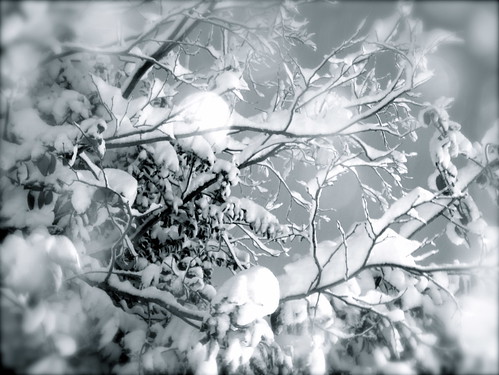With one door slammed shut I only had a couple of hours to come up with an alternate lesson plan and direction for my class. The day was damp with a slight drizzle in the air and about 10 to 12 inches of snow still covered our wooded paths. After a cup of coffee our educational coordinator told me about her experience with the United States Marines several years ago when her sergeant had them to practice their outdoor survival skills by building igloos after a two foot deep snowfall while stationed in Massachusetts. After some thought I got busy gathering several shovels and other tools for a class about igloos.
I had some old OSB board that I made an (18" long) X (12" wide) X (10" deep) box that had no top or bottom. As seen in the pictures we placed this box frame where the next "snow brick" would go, then proceed to pack snow into it and then finish by slipping it upwards leaving behind a nicely shaped block of snow. Originally this snowfall was dry-like and powdery but today's drizzle provided just the right dose of moisture to make the snow stick. Gradually the walls got higher and with each layer we had to also begin slanting the walls inward to make the roof. The kids also had to make some sculpting boards for shaping odd humps of snow smooth and for packing snow "mortar" in-between the snow bricks to make the wall one solid form.
Building the igloo was a somewhat messy job on this balmy February morning with a slight drizzle but the kids really took ownership of the project. I began with a short discussion about the origins of igloos and of course everyone related them to the native Eskimo people of northern Canada and Alaska. For many centuries these hardy and resourceful people have used the igloo as reliable shelter while on fishing and/or hunting expeditions while away from their tribes or villages. We also discussed how the igloo could be used as an emergency shelter when caught in a snowstorm in the wilderness and their ability to shield the body from deadly winter wind.
While building the igloo the kids came up with some brilliant questions. As he was packing snow mortar in-between the blocks of snow one student wondered how strong the walls would be. This provided an excellent opportunity for a casual conversation about how the ice blocks meet at the top of the igloo roof where the structural integrity is found by distributing the weight evenly in all directions.Questions like this are a teachers optimum opportunity to teach a lasting lesson because it was first generated by the students hands-on
 experience. We weren't in a warm classroom with beautifully organized desks with a teacher asking questions to the students from the front of the room... no, we were in a "real" classroom and the students were asking brilliant questions inspired by building an igloo with their own hands. This is the most powerful kind of learning and the kind of lesson that will last for a life time.
experience. We weren't in a warm classroom with beautifully organized desks with a teacher asking questions to the students from the front of the room... no, we were in a "real" classroom and the students were asking brilliant questions inspired by building an igloo with their own hands. This is the most powerful kind of learning and the kind of lesson that will last for a life time.An hour goes by fast when you're busy building and learning so we didn't quite finish the igloo today and we still need to close-in the remaining 1/3 of the roof. Despite the cold, the wet, and the mess these kids worked hard on their igloo today. Although I don't have any scout classes scheduled tomorrow, at lunch they asked me if they could try finishing it tomorrow if they could work it into their schedule so I granted them permission. I wonder how many teachers in a sterile and warm classroom setting get asked this question by their students. Education can be an intense and a powerful experience when students are engaged with their hands and then inspired by their own curiosity and imagination.


















What a great experience! I remember my Dad building one in our back yard the winter of 1976 or 7. That igloo lasted almost all winter and it was picture perfect. It was't untill I was in the Army in Alaska during our mounteneering training when we built another one. It was not as pretty as my Dad's, but it did keep us warm. ( the snow in Alaska is like sugar, it's so cold that it doesn't stick together so you have to cut tree limbs etc to make it work.) Ihope you can finish it before it taws like mister snowman!
ReplyDeleteLast night the temperatures went down just below freezing so the igloo survived it's first night. All of the snow blocks had fused into a very rock-solid wall. I think that it would have taken a sledge hammer to tear it apart after one night in the freezing temps.
ReplyDeleteI worked the rest of the day off campus and the temps went up into the mid fourties so I hope that enough of it has survived for the 25 degree low for the night. More snow is expected for Friday and Saturday so perhaps with a little "pampering" and adding more snow to the walls, we can extend it's life.
Also... amazing how well that we can recall quality hands-on experiences with our parents so many years ago. Thanks for sharing!